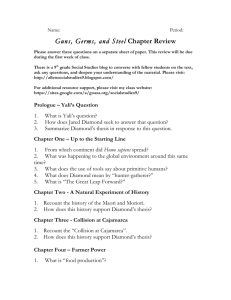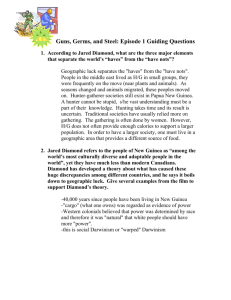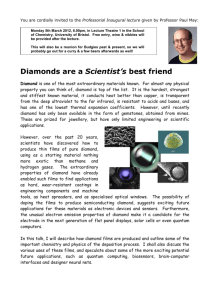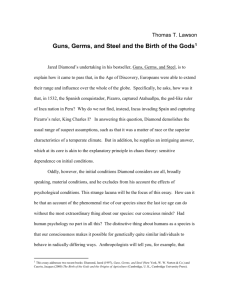WHAP Teacher Copy Guns Germ and Steel
advertisement
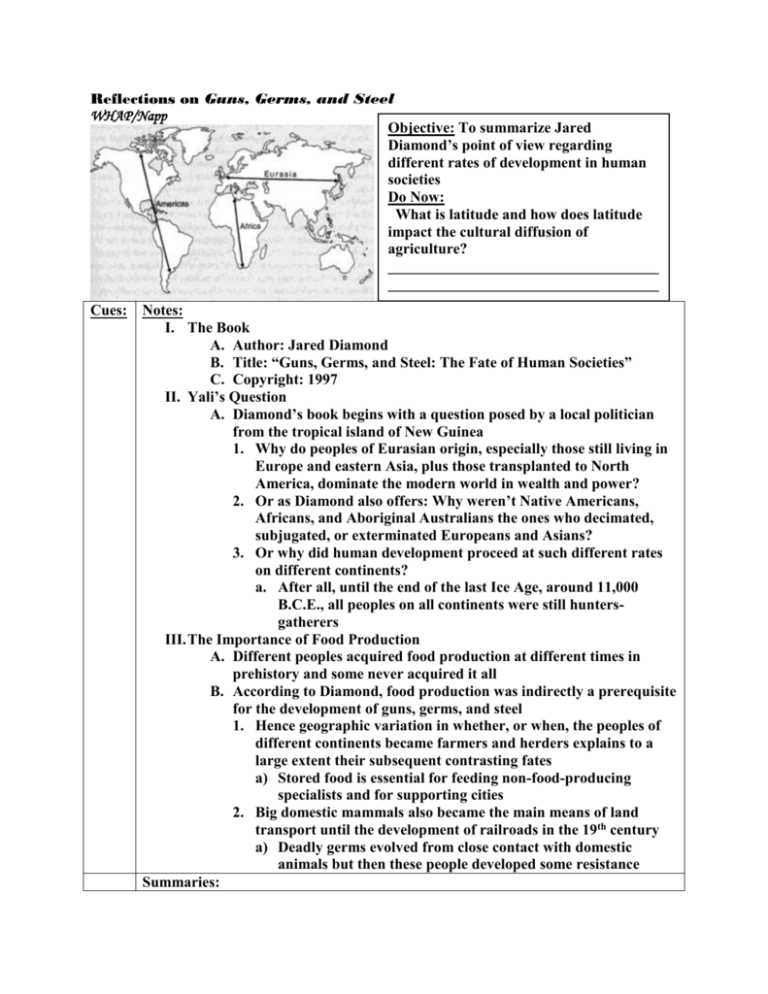
Reflections on Guns, Germs, and Steel WHAP/Napp Objective: To summarize Jared Diamond’s point of view regarding different rates of development in human societies Do Now: What is latitude and how does latitude impact the cultural diffusion of agriculture? ____________________________________ ____________________________________ Cues: Notes: I. The Book A. Author: Jared Diamond B. Title: “Guns, Germs, and Steel: The Fate of Human Societies” C. Copyright: 1997 II. Yali’s Question A. Diamond’s book begins with a question posed by a local politician from the tropical island of New Guinea 1. Why do peoples of Eurasian origin, especially those still living in Europe and eastern Asia, plus those transplanted to North America, dominate the modern world in wealth and power? 2. Or as Diamond also offers: Why weren’t Native Americans, Africans, and Aboriginal Australians the ones who decimated, subjugated, or exterminated Europeans and Asians? 3. Or why did human development proceed at such different rates on different continents? a. After all, until the end of the last Ice Age, around 11,000 B.C.E., all peoples on all continents were still huntersgatherers III. The Importance of Food Production A. Different peoples acquired food production at different times in prehistory and some never acquired it all B. According to Diamond, food production was indirectly a prerequisite for the development of guns, germs, and steel 1. Hence geographic variation in whether, or when, the peoples of different continents became farmers and herders explains to a large extent their subsequent contrasting fates a) Stored food is essential for feeding non-food-producing specialists and for supporting cities 2. Big domestic mammals also became the main means of land transport until the development of railroads in the 19th century a) Deadly germs evolved from close contact with domestic animals but then these people developed some resistance Summaries: Cues: Notes: IV. Five Areas Where Food Production Arose Independently A. Southwest Asia (known as the Near East or Fertile Crescent B. China C. Mesoamerica D. The Andes E. The Eastern United States V. Four Others – Candidates for Distinction A. Africa’s Sahel zone, tropical West Africa, Ethiopia, and New Guinea VI. But Fertile Crescent Significant Advantages A. World’s largest zone of Mediterranean climate and therefore it has a high diversity of wild plants and animal species 1. Goat, sheep, pig, and cow VII. Characteristics Necessary Candidates for Domestication A. Diet No mammalian carnivore domesticated too much food B. Growth Rate Must grow quickly C. Must Breed Well in Captivity D. Must Not Possess a Nasty Disposition E. Must Not Possess a Tendency to Panic F. Must live in herds with a defined hierarchy G. Thus, only a small percentage of animals are candidates for domestication H. But Eurasian peoples happened to inherit many more species of domesticable large wild mammalian herbivores than did peoples of other continents VIII. The Axes of Continents A. East/West Axis of Eurasia ideal for diffusion of crops/animals similar climate B. But Africa North/South Axis C. Americas North/South Axis D. And continental differences in axis orientation affected the diffusion not only of food production but also of other technologies and inventions IX. Disease A. Rise of agriculture launched the evolution of crowd infectious diseases could not be sustained in small groups B. Eurasian crowd diseases evolved out of diseases of Eurasian herd animals that became domesticated C. Eurasian germs played a key role in decimating the Native American Indians as well as native peoples in the Pacific islands, Australia, and southern Africa X. Diamond’s Conclusion A. Not innate differences in people but in their environments Summaries: Essential Question: Why was a continent’s axis orientation vital in determining the development of human societies on the continent? Why were the Europeans the people who were able to conquer so many of the world’s great civilizations and control so much of the world? 1. Groups who remained huntergatherers into the twentieth century lived in what types of areas? A. Areas near the equator B. Areas where natural resources were abundant C. Areas not fit for food production D. Areas with lots of water 2. What was needed for an area to become involved in food production? A. An abundance of wild game B. Several species of plants that could be domesticated C. A comfortable climate D. A North/South Axis 3. What is not a cause of uneven distribution of wealth and power, according to Diamond? A. Differences in wild plant distribution B. The relative isolation of people C. The orientation of a continent on a particular axis D. The intelligence of groups 4. Food production meant what to hunting and gathering societies? A. More nomadic lifestyles B. Fewer physical demands C. More physical work D. Fewer hours of labor each day 5. Hunter-gatherers in southeastern Europe adopted crops and agriculture from where? A. Africa B. Southwestern Asia C. North America D. China 6. The arrival of founder crops enabled local populations to become…? A. Obese B. Nomadic C. Rich D. Sedentary 7. Who invented things like firearms and steel equipment? A. Eurasians B. Australians C. Americans D. Africans 8. Where did technology grow fastest according to Jared Diamond? A. In isolated areas with small populations B. In nomadic societies C. In productive regions with large human populations D. In areas where food production was just beginning A Different Point of View: A Critique of Diamond’s Work: By Gene Callahan “…Diamond's central conception is that the course of history, broadly speaking, is not determined by individual actions, cultural factors, or racial differences, but by the environmental circumstances into which different groups of people accidentally wandered. More specifically, those groups that happened to wind up in places that offered a variety of plants and animals suitable for domestication, and that made acquiring domesticated species and new technologies from other societies relatively easy, wound up having a decisive advantage over groups located in environments lacking those features. As a result, when geographically advantaged societies encountered groups not so blessed, the outcome was inevitably that the former conquered or absorbed the disadvantaged culture. Thus it is geography, claims Diamond, and not greater inventiveness, a superior culture, or racial differences that is the "ultimate explanation" of why, for instance, Europeans came to rule the Americas rather than American Indians ruling Europe… “…In order to make his thesis plausible, Diamond must show that there were crucially important geographical differences between the homelands of those societies that wound up as conquerors and those that turned out to be the vanquished. He has exerted tremendous ingenuity in attempting to do so. I believe that he has succeeded to some extent, although it is a much more limited accomplishment than he ambitiously claims to have achieved… “[But] Diamond often has to put a good deal of spin on historical episodes. In attempting to explain why the Vikings did not successfully colonize the New World, while the Spaniards and the Europeans who followed in their wake did, he writes, "Spain, unlike Norway, was rich and populous enough to support exploration and subsidize colonies"… But this declaration simply brushes over the fact that Norway did successfully explore the North Atlantic, and did successfully colonize the Faeroe Islands and Iceland. If Diamond were true to his project…, he ought to proceed to formulate a quantitative law governing just how far from the mother country a colony can survive, given any particular amount of wealth and any number of residents in the colonizer. However, simply to state that requirement is to expose the attempt to stuff human history into a deductivist framework as the absurdity that it is… “…As I mentioned in the introduction, Diamond's mistake is not merely of concern to scholars. The view that "vast, impersonal forces" largely determine the course of history, whether those forces are taken to be "the material conditions of production," as in Marxism, or geographical circumstances, as in Diamond, naturally suggests that individuals can do little to affect their own future. As a logical consequence, in order to improve the lives of those who have been dealt a poor hand by those forces, it seems necessary to counteract them with another vast, impersonal force, namely, the State. Huge international programs intended to redress the arbitrary outcomes brought about by historical forces are recommended. The cases of countries with few geographic advantages but relatively free economies, such as Japan, prospering, and those of nations blessed with natural resources but ruled by highly interventionist governments, for example, Brazil or Nigeria, lagging behind, are easily dismissed as anomalies by those who are convinced that human action plays an insignificant part in history…”

